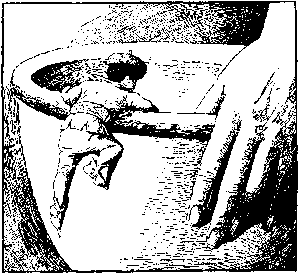|
At two inches tall, life offers quite a few hazards. In medieval England, Tom Thumb’s most recognizable adventure was the time he got baked into a pudding. Fortunately, he popped out healthy as ever. Other characters, however, don’t have his lucky escapes. Drowning or burning seem to be the most common deaths in for Thumblings, but particularly drowning or burning in food.
The Norwegian Tommeliten (Thumbikin) drowns in the smoroyet, or “butter eye” drizzled in the center of the porridge. On the same note, I recently came across two tales told by Norwegian storyteller Olav Eivindsson Austad. In both, a thumb-sized lad called simply Tume (Thumb) is accidentally killed by his mother. One suffocates in bread and the other drowns in buttered porridge. The buttered porridge incident in particular is probably a variant of Tommeliten. In a tale from Senovo, a character named Draganka drowns in a pot of beans. There are two variants in Bulgaria, one named Katsmatsura who is boiled up when she falls into a pot, and the other being an anthropomorphic rat. So why drown in food? None of these particular variants I’ve mentioned begin with food, but in fairytales, it’s very common for conception to be tied to the act of eating. A woman is told to eat a flower or a particular food to conceive. This is particularly true for thumbling tales. Some cut out pregnancy entirely and have the character created instantaneously from food – peas, gourds, or beans, usually chickpeas. A large number of oral thumbling tales begin with the woman wishing for a son while she’s cooking – the inciting incident is very often her stating her desire for a child to deliver his father’s lunch. The miraculous, instantaneous birth often then takes place in the kitchen. In a particular strain of the tale, a woman’s wish for children is answered with an impossible number of tiny chickpea children. Going instantly from wishing for a baby to being deluged with far too many hungry mouths to feed, she or her husband are driven to murder them. In some variants it seems to tie in with the idea of the parent finding their child boiled with the food - a very Hop o' My Thumb subject. There’s even a neat little list in the article “Catalogue Raisonn des Contes Grecs Types et Versions AT 700.” b: The mother (parent) kills them; by drowning them; b2: by throwing them into the pot; b3: by spraying with boiling water; b4: forcing them to return to the hole from which they came; b5: beating; b6: with a shovel; b7: the brush; b8: the basin of laundry; b9: the slipper; b10: other. Cheery subject. Back to the thumblings who meet a culinary doom. These usually seem to be cautionary tales – listen to your parents, don’t do foolish or dangerous things. The Bulgarian variants were probably a way to warn a child away from a hot fireplace. Text copyright © Writing in Margins, All Rights Reserved
0 Comments
Leave a Reply. |
About
Researching folktales and fairies, with a focus on common tale types. Archives
July 2024
Categories
All
|
Writing in Margins

 RSS Feed
RSS Feed
